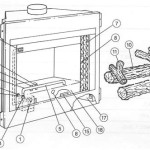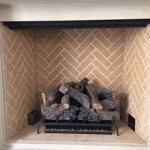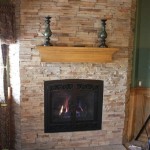Gas Fireplace Insert Fan: Enhancing Efficiency and Comfort
Gas fireplace inserts offer a convenient and efficient alternative to traditional wood-burning fireplaces. They provide warmth and ambiance without the hassle of wood storage and cleanup. However, the performance of a gas fireplace insert can be significantly enhanced with the addition of a fan. A gas fireplace insert fan, also known as a blower, plays a crucial role in distributing heat more effectively throughout a room, improving overall comfort and energy efficiency. This article delves into the workings of gas fireplace insert fans, exploring their benefits, types, installation considerations, maintenance requirements, and factors to consider when selecting the right fan for a specific application.
The primary function of a gas fireplace insert fan is to circulate the heated air generated by the fireplace insert. Without a fan, much of the heat remains concentrated around the fireplace, leading to uneven temperature distribution. The fan actively draws cool air from the room, passes it over the heated surfaces of the firebox, and then blows the warmed air back into the room. This process effectively spreads the heat, creating a more consistent and comfortable temperature throughout the space.
Benefits of Using a Gas Fireplace Insert Fan
The advantages of incorporating a gas fireplace insert fan extend beyond mere comfort. These benefits contribute to improved energy efficiency, cost savings, and enhanced safety.
Improved Heat Distribution: As previously mentioned, a fan significantly improves heat distribution by actively circulating warm air. This eliminates cold spots and ensures that the entire room benefits from the heat generated by the fireplace insert. This is particularly beneficial in larger rooms or open-concept living spaces where natural convection alone may not be sufficient to effectively distribute heat.
Increased Energy Efficiency: By distributing heat more evenly, a fan allows the fireplace insert to operate more efficiently. The thermostat controlling the fireplace can be set to a lower temperature while still maintaining a comfortable room temperature. This reduces the overall gas consumption and lowers energy bills. The fan essentially maximizes the heat output of the fireplace insert, ensuring that more of the generated heat is utilized effectively.
Faster Room Heating: A fan accelerates the heating process by actively circulating warm air. Instead of waiting for the room to gradually warm up through natural convection, the fan quickly disperses the heat, allowing the room to reach the desired temperature more rapidly. This is particularly advantageous during colder months when a quick and efficient heating solution is desired.
Reduced Surface Temperatures: While counterintuitive, a fan can help to reduce the surface temperatures of the fireplace insert itself. By constantly drawing cool air across the firebox, the fan helps to dissipate heat and prevent excessive accumulation. This can improve the longevity of the fireplace insert components and reduce the risk of overheating.
Enhanced Safety: In some instances, a fan can contribute to enhanced safety. By promoting air circulation and preventing heat buildup, the fan may reduce the risk of certain fire hazards associated with overheating. Additionally, some fan models incorporate safety features such as thermal overload protection, which automatically shuts off the fan if it overheats, preventing potential damage or fire risks.
Types of Gas Fireplace Insert Fans
Gas fireplace insert fans are available in various types, each with its own characteristics and suitability for different fireplace models and installations. The choice of fan depends on factors such as the fireplace insert's design, the desired airflow, and the noise level preference.
Axial Fans: Axial fans are the most common type of fan used in gas fireplace inserts. These fans utilize a rotating impeller with blades to draw air in a parallel direction to the axis of rotation. Axial fans are generally compact, relatively quiet, and cost-effective. They are suitable for applications where moderate airflow is required.
Centrifugal Fans (Blowers): Centrifugal fans, also known as blowers, are designed to deliver higher airflow and pressure compared to axial fans. These fans utilize a rotating impeller with curved blades to draw air in a perpendicular direction to the axis of rotation and then expel it outward at a higher velocity. Centrifugal fans are often used in larger fireplace inserts or in situations where more powerful airflow is needed to distribute heat effectively.
Tangential Fans: Tangential fans, also referred to as crossflow fans, are characterized by their long, cylindrical shape and their ability to produce a uniform airflow across their entire length. These fans are often used in fireplace inserts where a wide and consistent airflow is desired. Tangential fans are known for their quiet operation and their ability to distribute heat effectively over a large area.
Variable Speed Fans: Many gas fireplace insert fans are equipped with variable speed controls, allowing the user to adjust the airflow according to their preferences. Variable speed fans offer greater flexibility and control over the heating process. At lower speeds, they operate more quietly and consume less energy, while at higher speeds, they provide maximum heat distribution.
Thermostatically Controlled Fans: Some fan models incorporate a thermostat that automatically turns the fan on or off based on the temperature of the fireplace insert. Thermostatically controlled fans provide a convenient and energy-efficient way to regulate the heat output of the fireplace. The fan will only operate when the fireplace is generating sufficient heat, preventing it from running unnecessarily and wasting energy.
Installation and Maintenance Considerations
Proper installation and regular maintenance are essential for ensuring the optimal performance and longevity of a gas fireplace insert fan. Incorrect installation can lead to reduced airflow, increased noise, and potential damage to the fan or the fireplace insert.
Professional Installation: It is generally recommended that a qualified technician install the gas fireplace insert fan. A professional installer will have the necessary expertise and tools to ensure that the fan is properly mounted, wired, and connected to the fireplace insert's power supply. Professional installation also ensures that the fan is compatible with the specific fireplace insert model and that it meets all applicable safety codes and regulations.
Power Supply: The gas fireplace insert fan requires a dedicated power supply. This is typically a standard 120V AC outlet located near the fireplace insert. The fan should be connected to the power supply using a properly sized electrical cord and plug. It is important to ensure that the power outlet is properly grounded and that the electrical wiring is in good condition.
Airflow Clearance: Proper airflow clearance around the fan is crucial for efficient operation. Obstructions such as furniture or draperies can restrict airflow and reduce the fan's performance. Ensure that there is adequate space around the fan to allow for unrestricted air intake and exhaust. The manufacturer's instructions will provide specific recommendations for airflow clearance.
Cleaning and Maintenance: Regular cleaning and maintenance are essential for keeping the gas fireplace insert fan operating smoothly and efficiently. Dust and debris can accumulate on the fan blades and motor, reducing airflow and increasing noise. Periodically clean the fan blades and motor using a soft brush or vacuum cleaner. Refer to the manufacturer's instructions for specific cleaning recommendations. Some fan models may require occasional lubrication of the motor bearings.
Troubleshooting: If the gas fireplace insert fan is not functioning properly, there are several troubleshooting steps that can be taken. First, check the power supply to ensure that the fan is receiving power. Next, inspect the fan blades for any obstructions or damage. If the fan is making excessive noise, it may be necessary to lubricate the motor bearings or replace the fan assembly. If the problem persists, consult a qualified technician.
Selecting the appropriate gas fireplace insert fan requires careful consideration of various factors to ensure compatibility, efficiency, and desired performance. Understanding these factors will enable informed decision-making and optimize the benefits of the fan.
Factors to Consider When Selecting a Gas Fireplace Insert Fan
Choosing the right gas fireplace insert fan involves evaluating several key characteristics to meet the specific needs of the fireplace and the homeowner.
Fireplace Insert Compatibility: The most critical factor is ensuring that the fan is compatible with the specific model of the gas fireplace insert. The manufacturer's specifications will indicate the recommended fan type, size, and airflow requirements. Using an incompatible fan can lead to reduced performance, increased noise, or even damage to the fireplace insert.
Airflow Requirements: The desired airflow depends on the size of the room and the level of heat distribution required. Larger rooms will generally require a fan with higher airflow. The airflow is typically measured in cubic feet per minute (CFM). The manufacturer's specifications will provide guidance on selecting a fan with the appropriate CFM rating for the specific fireplace insert and room size.
Noise Level: The noise level of the fan is an important consideration, especially for individuals who are sensitive to noise. Fan noise is typically measured in decibels (dB). Lower decibel ratings indicate quieter operation. Variable speed fans allow the user to adjust the airflow and noise level according to their preferences.
Energy Efficiency: Energy-efficient fans consume less electricity while delivering the same level of airflow. Look for fans with energy-efficient motors and variable speed controls. Thermostatically controlled fans can also help to reduce energy consumption by only operating when the fireplace is generating sufficient heat.
Durability and Reliability: Choose a fan from a reputable manufacturer with a proven track record of producing durable and reliable products. Consider the materials used in the fan's construction and the warranty offered by the manufacturer. A well-built fan will provide years of trouble-free operation.
Ease of Installation: While professional installation is generally recommended, some fan models are designed for easy DIY installation. If you are comfortable with basic electrical wiring, you may be able to install the fan yourself, provided that you carefully follow the manufacturer's instructions. However, it is always best to consult with a qualified technician if you are unsure about any aspect of the installation process.
Cost: The cost of a gas fireplace insert fan can vary depending on the type, size, features, and manufacturer. Consider the overall value of the fan, including its performance, durability, and energy efficiency, when making a purchasing decision. It is important to balance cost with quality and performance to ensure that you are getting the best value for your money.

Fireplace Efficiency Blowers And Why You Should Have One

Noisy Gas Fireplace Blower Here S How To Replace It Diy

Why Should I Get A Fireplace Blower For My Masonry

Installing A Fireplace Blower Gfk4 Gfk4a In Heatilator Natural Gas

How To Buy A Gas Fireplace Insert Buyer S Guide From Regency

Fireplace Blower Fans What You Need For Heat Full Service Chimney

Fireplace Blowers Explained How Fans Work Regency

Gas Fire Insert Fan Assisted Efficient Spain Manufacturer Ambifuego

How To Choose And Install A Gas Fireplace Blower Kit

Why Do I Need A Blower Fan On My Fireplace We Love Fire
Related Posts








